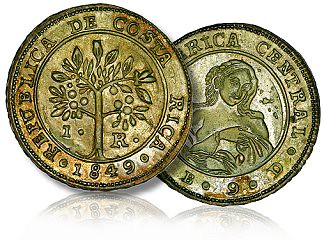
PREV ARTICLE
FULL ISSUE
PREV FULL ISSUE
FEATURED WEB PAGE: FREDERICK MAYER COLLECTION OF COSTA RICAN SILVER COINSThis week's Featured Web page is a 2008 CoinLink article by Greg Reynolds on the auction of the Frederick Mayer collection of Costa Rican silver coins.

Costa Rican silver coins of the 19th century are often confusing because the monetary system was changed four times. The first system stemmed from that of the Spanish Empire. Sixteen silver reales equaled one gold escudo. The Eight Reales silver coins, of the Spanish Empire, were the basis for U.S. silver dollars. The term ‘two bits' refers to Two Reales coins which were about equivalent to U.S. quarters. From the 1790s to the 1830s, U.S. quarters were not often seen in circulation in the U.S., and Two Reales coins of the Spanish Empire served as quarters in the U.S. It was very common then for Two Reales coins to be given in change when purchases were made with U.S. half dollars or gold coins. Indeed, the silver coins of the Spanish Empire circulated widely in the U.S. at least until the 1860s, and circulated to some extent in the West until the 1880s. In the 1840s, there were probably more Spanish Empire silver coins in circulation in the U.S. than there were U.S. Liberty Seated coins. One Real could be thought of as being worth around 12˝ U.S. cents. A Four Reales coin thus paralleled a U.S. half dollar. Coins of the Spanish Empire and their direct descendants are very much a part of the monetary history of the United States.
www.coinlink.com/News/world-coins/
|
